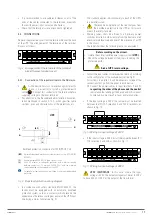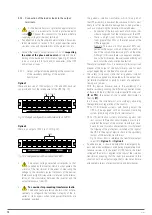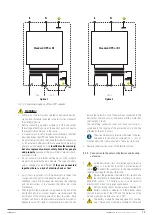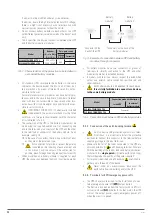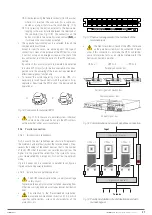
6
SALICRU
3. QUALITY ASSURANCE AND STANDARDS.
3.1. STATEMENT BY THE MANAGEMENT.
Our goal is customer satisfaction, therefore this Management
has decided to establish a Quality and Environment Policy,
through the implementation of a Quality and Environmental
Management System that will enable us to comply with the
requirements demanded in the
ISO 9001
and
ISO 14001
and
also by our Customers and Stakeholders.
Likewise, the management of the company is committed to
the development and improvement of the Quality and Environ-
mental Management System, through:
•
Communication to the entire company of the importance
of satisfying both the customer's requirements as well as
legal and regulatory requirements.
•
The dissemination of the Quality and Environment Policy
and the setting of the Quality and Environment objectives.
•
Conducting reviews by the Management.
•
Providing the necessary resources.
3.2. STANDARDS.
The SLC TWIN PRO2 T is designed, manufactured and sold in
accordance with Quality Management Standard
EN ISO 9001
.
The
EC
marking indicates conformity with EU Directives:
•
2014/35/EU
- Low voltage safety.
•
2014/30/EU
- Electromagnetic compatibility [EMC]
•
2011/65/EU
- Restriction of the use of hazardous substances
in electrical and electronic equipment [RoHS]
In accordance with the specifications of harmonised standards:
•
EN-IEC 62040-1
. Uninterruptible power supplies [UPS].
Part 1.1: Safety requirements.
•
EN-IEC 62040-2
. Uninterruptible power supplies [UPS].
Part 2: Electromagnetic compatibility [EMC] requirements.
WARNING:
SLC TWIN PRO2 T UL 6 and 10 kVA
. This
is a category C3 UPS. This is a product for
commercial and industrial application in the second
environment; Installation restrictions or additional
measures may be necessary to avoid disturbances.
It is not appropriate to use this device in basic life
support applications [BLS], where a failure of the
former can render vital equipment out of service or
significantly affect its safety or effectiveness. It is also
not recommended in medical applications, commercial
transport, nuclear installations, or other applications
or loads, where a failure of the product can lead to
personal or material damage.
The EC declaration of conformity of the product is
available to the customer upon express request to our
offices.
And
UL, CSA and FCC
markings in accordance with the
specifications of standards:
•
UL 1778
•
CSA C22.2 NO.107.3.-14
•
FCC part 15 Subpart B
ELECTROMAGNETIC COMPATIBILITY WARNING
(FCC):
•
SLC TWIN PRO2 T UL 6 and 10 kVA
. This UPS has been
tested and meets the limits for a Class B digital device, pur-
suant to the FCC Part 15 standard. These limits are defined to
provide reasonable protection against harmful interference
when the device operates in a commercial environment.
This device generates, uses and can radiate radio frequency
energy and, if not installed and used in accordance with
the instruction manual, may cause harmful interference
to radio communications. Operation of this UPS in a
residential environment may cause harmful interference, in
which case the user must correct the interference at their
own expense.
The manufacturer is not liable in the event of modifica-
tion or intervention on the device by the user.
WARNING CONCERNING BATTERIES (UL):
•
Maintenance of the batteries must be carried out or super-
vised by personnel who have knowledge of the batteries
and the necessary precautions.
•
Batteries should not be replaced by the operator or user.
•
When changing batteries, replace them with the same type
and number.
•
Caution:
: Do not dispose of batteries in fire, as they
may explode.
•
Caution:
Do not open or break apart batteries. The
electrolyte discharged can be harmful to the skin
and eyes. It can be toxic.
•
Caution:
Batteries can pose a risk of electrocution
and cause a high short-circuit current. The following
precautions should be observed when working with them:
a.
Remove any watches, rings or other metal objects.
b.
Use tools with insulated handles.
c.
Wear gloves and rubber boots.
d.
Do not leave tools or metal objects on top of the bat-
teries.
e.
Disconnect the power source before connecting or dis-
connecting the battery terminals.
f.
Determine whether the battery is accidentally earthed.
If so, disconnect the power source. Contact with any
part of a battery that is earthed can cause electrocution.
The likelihood of electrocution can be reduced if such
connections are eliminated during installation and
maintenance (applicable to devices and battery cabinets
that do not have a power circuit connected to earth).

















